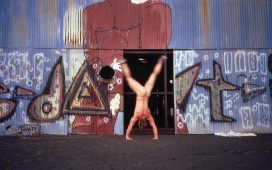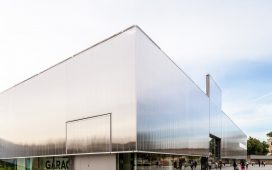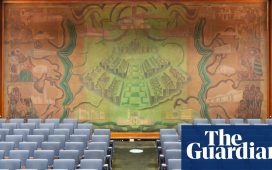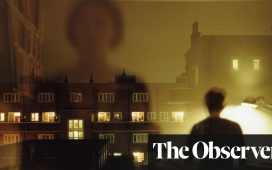Success as an architect came late to Eldred Evans, who has died aged 85. In 1989, she and her life/work partner David Shalev won a competition to design a branch of the Tate Gallery in St Ives, Cornwall. Tucked against the hillside behind modern housing, the building announced itself by a circular entrance, built on the foundations of the town’s former gasholder to keep within budget.
Opened in 1993, the gallery attracted many more visitors than anticipated – 120,000 in six months – and the entrance that had seemed so extravagant rapidly became too small. The Evans & Shalev practice returned to add an education room in 2017 as part of an expansion scheme by Jamie Fobert that broadly respected their original work.
Glass bricks and trellis patterns gave incident to a building conceived with a classical grandeur surprising for a modern architect. However, as a student at the Architectural Association in London and at Yale University, Evans had studied the work of Louis Kahn in America and Gunnar Asplund in Stockholm, architects who similarly transcended the divide between classicism and modernism. She abhorred the term “postmodernism”, though her mature work, embracing many stylistic elements, reflected an architecture-after-modernism in its truest sense.
An earlier hybrid work was Truro law courts, built in 1986-88 and now a listed building. Evans & Shalev had won a competition for a library at the Royal Military College in Shrivenham, Oxfordshire, only for it to be cancelled with the outbreak of the Falklands war. But Britain needed more law courts and Michael Heseltine at the Department of the Environment sought to prove himself as an architectural patron, so gave the practice this more substantial commission.
The site was cramped and the budget tight, yet the interior shines with natural light and the complex circulation – rigorously separating the public, lawyers and defendants – appears generous. Glass bricks and classical columns made this possible, while the concrete was rendered to blend with Truro’s grey stone.

Evans claimed her favourite building was the library she added to Jesus College, Cambridge, after winning another competition in 1991. Opened in 1996, it resembles a classical brick villa with touches of Charles Rennie Mackintosh and Kahn in the largely white interior, for which Evans also designed the furniture. Its success led to a residential range at the college (1997-2000). The Bede Museum, Jarrow (now part of Jarrow Hall), Tyne and Wear (1993-2000), similarly blended classical details with trelliswork despite housing Anglo-Saxon artefacts.
Yet at the turn of the 1960s, Evans had been the most modern force in British architecture. The outstanding student of her year at Britain’s foremost architecture school, she won an international competition with her final thesis in 1961, when aged 23. This was for a civic centre at Lincoln, shops and magistrates’ courts set in a pedestrian precinct round a council chamber over car parking. While she sourced concrete blocks (then novel) from the Netherlands, the brutalist architecture was also respectful of its historic setting. The competition assessors, who included Leslie Martin and Geoffrey Jellicoe, among the leading architects of the time, declared it “outstanding”.
Evans briefly joined Richard Rogers and Norman Foster to study at Yale, but then was called back to Lincoln. It turned out that the city council had owned only half the site, and a revised smaller scheme was required. Later the plan was abandoned altogether with the death of the council leader. Evans blew her prize money on a second-hand Rolls-Royce, itself a statement of her style and individuality.

Thereafter, Evans’s career was dogged by disappointment. She won 18 competitions, many with Shalev, yet few were built. One was for housing in Broadclyst, Devon, in 1965, where the National Trust turned instead to a local builder. Her first realised building was a school at Newport, Gwent, in 1969-72 – a response to the need to break down a large comprehensive school into small units so children did not feel anonymous. It was demolished in 2009.
A children’s reception centre at Alexandra Road, Camden, north London, was also designed as a series of modules, and never operated as intended. A home for disabled young adults – bedsits grouped around a social space linked by a sculptural wheelchair ramp – was loved by early residents but became a care home for elderly people in the 1990s after requirements changed. Another competition win, for a residence for Jack Lynch, the Irish taoiseach, was abandoned in 1980 following his resignation. There was work for private clients, mainly introduced through Shalev and including a large, steel-framed factory at Paddock Wood, Kent, but the couple supported themselves mainly by teaching.
Eldred was born in London, the only daughter of Merlyn Evans and Phyllis Sullivan, artists who had met at the Royal College of Art. They emigrated to South Africa in 1938 when Merlyn secured a teaching post, and later divorced. Eldred returned to London to live with her father (to whom she was close) after first studying at Witwatersrand University. She thought of becoming a doctor, but lacked the necessary qualifications, while she had drawn from an early age.
Her closest friends at the AA were Ada and Ram Karmi, who asked Evans to look after a fellow Israeli architect, David Shalev, visiting London in their absence. She organised a dinner party, and they instantly bonded. Evans & Shalev opened an architectural practice in 1964, but deliberately kept it small, with never more than five assistants – very different from the experience of Foster and Rogers, who nevertheless recognised Evans as “a goddess”.
Shalev, whom she married in 2001, died in 2018. Evans is survived by their daughter, Elantha, an architect.








